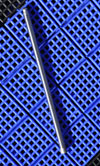Tool steel for pushrods adds strength and reliability
 A strong and stable valvetrain is essential to power an NHRA Full Throttle Drag Racing Series Top Fuel rail down the 1000-foot dragstrip. For that reason, teams are always looking to improve stability of the pushrod.
A strong and stable valvetrain is essential to power an NHRA Full Throttle Drag Racing Series Top Fuel rail down the 1000-foot dragstrip. For that reason, teams are always looking to improve stability of the pushrod.
For a long time, Kenny Bernstein Racing used only hollow pushrods - and purchased those exclusively from Manton Pushrods in Lake Elsinore, California. While the Top Fuel team continues to work with Terry Manton for its pushrods, the specification has changed. "We've gone to stiffer pushrods using tool steel in 7/16-inch size, using intakes at 10/700 and exhausts at 11/600.
"We haven't always used solids but we've gone that route to make everything stiffer and stronger," said co-crew chief Rob Flynn, working with Mike Guger and Todd Smith on Brandon Bernstein's Copart-sponsored machine. "Everybody's choice of length is a little bit different," Smith chimed in. "It depends on the combination you're running."
While the solid, tool steel pushrod is a brand new combination for the Bernstein team in 2010, "I couldn't tell you that we have noticed much difference because we don't have enough runs on them yet," Flynn said before Gainesville, the third of 23 races. "We didn't have to change rocker arm configurations at all. It's the same length and everything; it's just a different pushrod, that's all."
The Bernstein team was not having any issues with its hollow pushrods; the reason they switched was for strength and reliability. "Even though we were not having reliability problems, we felt we might be able to make more power with this unit and, thus far, it has been fine," Flynn allowed.
Flynn, Guger and Smith make sure the crew checks their pushrods after every run. "If there is some issue with run-up, then we will change them, but really," Flynn noted, "it is a pretty reliable part. Easily, our pushrods will go through a race weekend. Last year, for example, we hardly bought any pushrods and we were running hollow rods."
The Bernstein team changed to the tool steel, solid pushrod for the 2010 season. "A lot of the people that were using tool steel last year would send them back to get new cups put on them, but that was about it. That pretty much speaks about how reliable they are." While some components are chosen for lighter weight, Flynn believes the weight of a pushrod is not a huge thing.
According to Manton, the change from chrome moly to tool steel "made a strength increase of 22 percent, which calculates into a stiffer pushrod tube that is the same outside diameter (as a hollow piece). The stiffer pushrod means greater lift at the valve and an improved valve action in relation to cam position."
With reference to this improvement in stiffness and strength, "At this point we don't have any issues with the pushrod," Smith admitted. "Unless we bend them - and that usually happens on the exhaust side because cylinder pressures are so high it doesn't want to open so you get deflection on the shaft," he pointed out.
No one in the Top Fuel ranks really knows their cylinder pressure. Flynn said that most teams have no way to measure it. "I'm sure there is someone you could bug and they'd give you some number, but all of us don't know. It's all a guesstimate."
Tuning for the new pushrod combination is not a black art. "It is all based on what you have done and what you know works. If you get something that works, then you learn how to get more out of your engine and find the weak link, build that part up to make it stronger," Smith said. "It is all a basic evolution."
Fig. 1 - Kenny Bernstein Racing went from hollow to tool steel solid Manton pushrods to gain strength and reliability
Words and photo by Anne Proffit